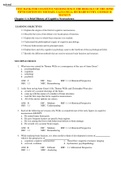Exam (elaborations)
TEST BANK FOR COGNITIVE NEUROSCIENCE THE BIOLOGY OF THE MIND FIFTH EDITION BY MICHAEL GAZZANIGA, RICHARD B IVRY, GEORGE R MANGUN
TEST BANK FOR COGNITIVE NEUROSCIENCE THE BIOLOGY OF THE MIND FIFTH EDITION BY MICHAEL GAZZANIGA, RICHARD B IVRY, GEORGE R MANGUN-LEARNING OBJECTIVES 1.1 Explain the origins of the field of cognitive neuroscience. 1.2 Describe the roots of the debate over localization of function. 1.3 Explain the...
[Show more]













